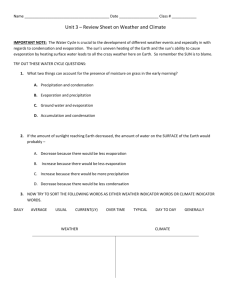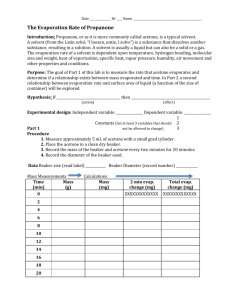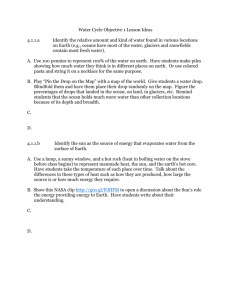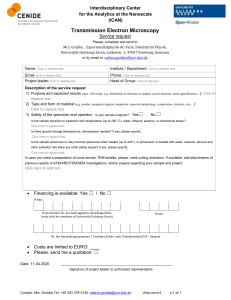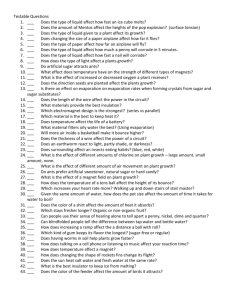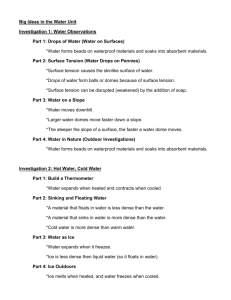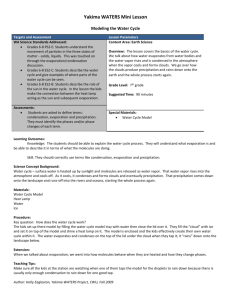Word Format
advertisement
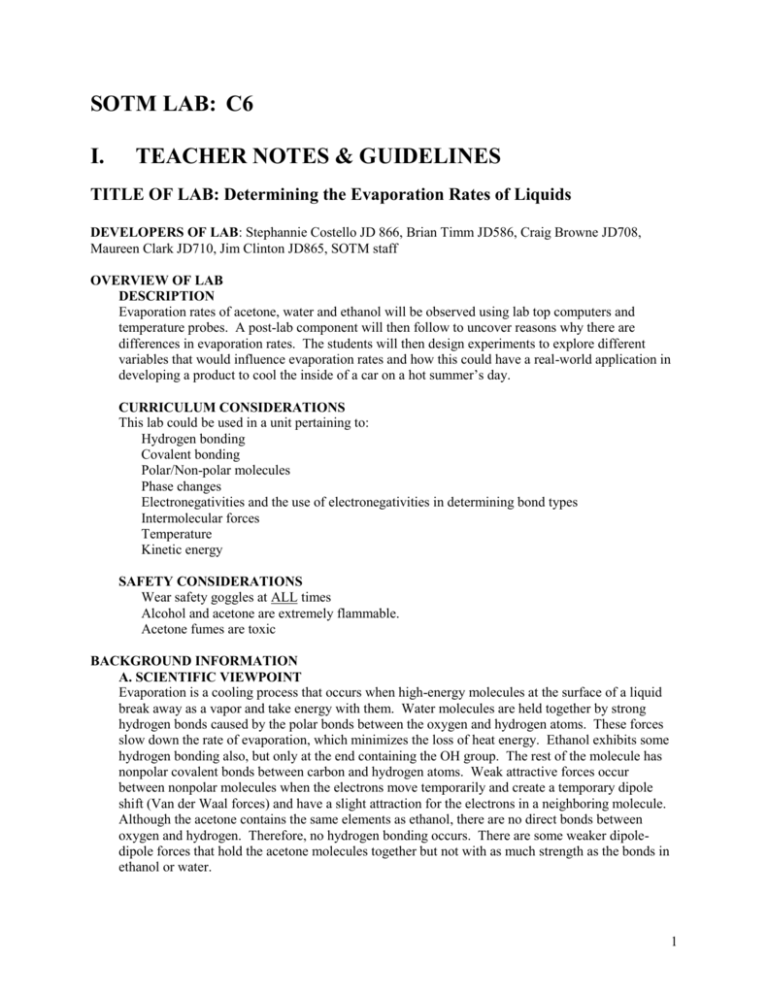
SOTM LAB: C6 I. TEACHER NOTES & GUIDELINES TITLE OF LAB: Determining the Evaporation Rates of Liquids DEVELOPERS OF LAB: Stephannie Costello JD 866, Brian Timm JD586, Craig Browne JD708, Maureen Clark JD710, Jim Clinton JD865, SOTM staff OVERVIEW OF LAB DESCRIPTION Evaporation rates of acetone, water and ethanol will be observed using lab top computers and temperature probes. A post-lab component will then follow to uncover reasons why there are differences in evaporation rates. The students will then design experiments to explore different variables that would influence evaporation rates and how this could have a real-world application in developing a product to cool the inside of a car on a hot summer’s day. CURRICULUM CONSIDERATIONS This lab could be used in a unit pertaining to: Hydrogen bonding Covalent bonding Polar/Non-polar molecules Phase changes Electronegativities and the use of electronegativities in determining bond types Intermolecular forces Temperature Kinetic energy SAFETY CONSIDERATIONS Wear safety goggles at ALL times Alcohol and acetone are extremely flammable. Acetone fumes are toxic BACKGROUND INFORMATION A. SCIENTIFIC VIEWPOINT Evaporation is a cooling process that occurs when high-energy molecules at the surface of a liquid break away as a vapor and take energy with them. Water molecules are held together by strong hydrogen bonds caused by the polar bonds between the oxygen and hydrogen atoms. These forces slow down the rate of evaporation, which minimizes the loss of heat energy. Ethanol exhibits some hydrogen bonding also, but only at the end containing the OH group. The rest of the molecule has nonpolar covalent bonds between carbon and hydrogen atoms. Weak attractive forces occur between nonpolar molecules when the electrons move temporarily and create a temporary dipole shift (Van der Waal forces) and have a slight attraction for the electrons in a neighboring molecule. Although the acetone contains the same elements as ethanol, there are no direct bonds between oxygen and hydrogen. Therefore, no hydrogen bonding occurs. There are some weaker dipoledipole forces that hold the acetone molecules together but not with as much strength as the bonds in ethanol or water. 1 B. COMMON MISCONCEPTIONS Misconception 1, Heating and cooling make molecules change, not just move faster and slower. 2. Temperature is a measure of heat and cold inside an object. 3. The temperature of an object is a measure of the amount of heat it contains. 4. Evaporation and boiling are chemical changes: e.g. hydrogen is separated from the oxygen and that is what the bubbles are. 5. No concept of intermolecular forces affecting the rate of evaporation. They only think speed of molecules influences evaporation. 6-When a substance evaporates, it vanishes. Concept Heating and cooling are physical changes only, affecting the potential or kinetic energy of molecules. Temperature is a measure of the AVERAGE kinetic energy of a sample’s particles. Heat is measured in calories or joules, not degrees. Heat is the TOTAL kinetic energy of a sample’s particles. Evaporation and boiling are phase changes, not chemical changes. Van der Waals forces, hydrogen bonding and dipole forces influence rate of evaporation. Matter can not be created or destroyed. OBJECTIVES This lab can serve as a review of the kinetic theory and its relation to evaporation and the thermodynamics of evaporation. Students should be able to explain how hydrogen bonding and other intermolecular forces of attraction effect the rate of evaporation. Students will be able to use structural models and electronegativity values to explain how bond types influence the evaporation of a liquid. Students will construct a control/variable experiment and make predictions of its outcome. This lab will encourage cooperative and active learning among students to explore entrepreneurial opportunities EQUIPMENT/MATERIALS PROVIDED BY SOTM Laptop computer Science Workshop interface Temperature sensor PROVIDED LOCALLY Distilled water Acetone Ethanol 3 test tubes Test tube rack Paper towel Goggles and lab apron Scissors Metric ruler Stoppers Parafilm Class set of small pump spray bottles 2 ADVANCE PREPARATION: Procedure for Pasco setup: 1. Connect the Science Workshop interface to the computer. 2. Connect the DIN plug of the temperature sensor into the Analog Channel A of the interface. (You do not need to calibrate the temperature probe.) 3. Turn on the interface 4. Open and start computer 5. Open Science Workshop by double clicking on the Science Workshop icon. 6. On the computer interface screen, click and drag the analog plug icon to channel A on the interface, where the temperature probe has been plugged. 7. From the sensor list shown, scroll to and select the basic temperature sensor. 8. At the interface screen, click and drag the Graph icon and drop it on the temperature probe icon. 9. Do the same for the table icon. 10. Arrange the various windows by clicking and dragging on the title bar at the top of each window. Move the windows until all are visible. Make the windows smaller or larger as needed by clicking and dragging on the edge of the window. II. PRE-LAB EXERCISE TO ELICIT STUDENTS’ PRIOR KNOWLEDGE AND MISCONCEPTIONS Students are given the following questionnaire to assess their misconceptions: What causes a liquid to evaporate? When a liquid evaporates, where does it go? What’s the difference between evaporation and boiling? How can you make a liquid evaporate faster or slower? Do all liquids evaporate at the same rate? If not, why not? When a substance evaporates, does it cool down or warm up? DISCUSSION OF PRECONCEPTIONS Correlate the answers from the pre-lab exercise to determine which misconceptions the student has. III. EXPLORATION OF SCIENTIFIC PRINCIPLE & INTRODUCTION OF EXPERIMENTAL PROTOCOL PROBLEM: Determine the evaporation rates of water, acetone, and ethanol. EXPERIMENT AND TECHNICAL OPERATION OF EQUIPMENT 1. Obtain 3 mL of acetone. Place it in a labeled and stoppered test tube (parafilm may be used in place of the stoppers). Place the test tube in a test tube rack. 2. Repeat step 1 with distilled water and ethanol. 3. Cut 3 pieces of l cm x 3 cm rectangles of paper towel. 4. Wrap the end of the temperature sensor with 1 piece of the cut paper towel so that it is totally covered with no metal showing. Attach the paper to the probe by wrapping a strip of parafilm around the section of paper NOT covering the temperature probe. 5, To check if the equipment is working correctly, click on the MON button on the computer screen. When you see data points on the graph display, click on the STOP button. 3 6. Remove the cork or parafilm from the acetone test tube and dip the paper towel covered end of the sensor into the liquid. Remove the sensor and click the REC “button”. Allow the liquid to evaporate for 2 minutes (120 sec.) Do not blow on the sensor. 7. Observe the graph being produced. At the end of 120 seconds, click on the STOP button." 8. Remove the paper towel from the sensor and dispose of it. 9. Repeat steps 4 - 8 for both water and ethanol, separately. All 3 curves produced should be on the same graph. To display all the curves, click on DATA in the graph window and be sure there is a check mark in front of all sets of data. 10. Save your data and graphs on a disk in drive A as EVAP1. Your teacher will print your graphs for you. Teacher Notes: It is obvious from the sample data shown on Fig 1 on the graph that there is a significant difference in the rates of evaporation of the 3 liquids. By drawing the best-fit straight lines for the falling portion of each curve, it is possible to make a relative comparison between these rates. The expression for the rate of evaporation of each liquid is: acetone: y = 0.2x + 24 ethanol: y = 0.07x + 24 water: y = 0.03x + 24 Acetone evaporates at the fastest rate and the water at the slowest rate. An eventual increase in temperature for the acetone and ethanol trials may occur if all of the liquid has completely evaporated and the probe begins to warm up to room temperature. Any rise in temperature will be less noticeable if excess liquid is placed on the piece of paper towel. Related Web sites: www.sos-tek.com www.mistngo.com www.kesmist.com/nozzle4.htm www.mistymate.com 4 POST-LAB QUESTIONS: 1. Draw a best-fit line along the falling portion of the data points for each curve. Calculate the slope of each line. What does the slope of each line represent? 2. Rank the liquids from slowest to fastest evaporation rates. 3. Use electronegativities and structural formulas to determine the bond type and polarity of the water, acetone and ethanol molecules. Which molecule is the most polar? Why? 4. Describe the types of attractive forces that hold water, acetone and ethanol molecules together. 5. Explain why different liquids evaporate at different rates. 6. What prevents liquids from evaporating? 7. Examine the predictions you made about the rates of evaporation for water, acetone and ethanol prior to the lab. Were they accurate? Why or why not? 8. What did you learn from this lab that you previously did not know or did not understand? 9. Why do some window cleaners leave spots? If you were a chemical engineer for the cleaning corporation how would you solve this problem? 5 IV. ELABORATION OF SCIENTIFIC PRINCIPLE: INQUIRY-BASED STUDENT INVESTIGATION Teacher Notes: (Questions that can be used to start students in their inquiry assignments) Does the temperature of the room affect evaporation rate? Does the humidity of the room affect evaporation rate? Does the airflow of the room affect evaporation rate? What are the evaporation rates of some common household products? Why do mist fans work? What does the experiment with alcohol and acetone tell you about how nail polish and alcohol swabs work? Why do muscle creams make you feel hot and cold at the same time? Can you create a liquid that when sprayed will lower the temperature of a closed car passenger compartment in the summer? PROBLEM: Option 1 - Students are to create a solution that when used in a pump spray bottle can lower the temperature of a closed car passenger compartment in the summer. Option 2 - Students are to investigate the cooling rates of various household products. Option 3 - Students are to investigate factors that affect the cooling rate of a specific liquid. HYPOTHESIS OR PREDICTION What type of solution will work best at lowering the temperature of a passenger compartment? What household materials evaporate the fastest and why? What factors affect the rate of evaporation of a known material? EXPERIMENTAL DESIGN Option 1 - Students are to design a solution and a method for testing their solution. Before the student can proceed to the next step, they must check with the teacher Option 2 - Students will collect data runs on various household products and explore and explain the intermolecular forces that support their data. Option 3 - Students are to investigate what factors will affect the rate of cooling for a known material. Checkpoint (Teacher checks students’ experimental design for feasibility.) 6 RUBRIC FOR ASSESSMENT OF STUDENT INQUIRY LAB Student’s Name___________________________ Student activity Students have proposed a question. Students have proposed a hypothesis. Students have stated reason for predicted outcome. Students have created procedure Students have considered safety and viability. Students have identified controls. Students have identified variables. Students have created a material list. Students have successfully run procedure. Students have recorded data correctly. Students have completed calculations. Students have listed % error and sources of error. Students have proposed ways to improve the procedure. Have students tested their hypothesis? Are the student’s conclusions consistent with their data? Are student’s data, calculations and outcome logical and consistent with known scientific concepts? What new questions have arisen during this lab? Date of Completion Teachers Initials 7 Student’s Name ______________________ PLAN FOR DATA COLLECTION & ANALYSIS (Teacher’s note: Questions you may want to use to guide students through planning their inquiry) What question do you want to answer? What is your hypothesis? What do you think will be your outcome? Are you only testing one variable? How are you keeping all other conditions unchanged? Will you be able to get all of the materials that you will need? Checkpoint (Teacher checks students’ plan for feasibility.) CONDUCTING THE EXPERIMENT (Teacher’s note: Questions you may want to use to guide students through conducting their inquiry) Do you have all of the materials needed to conduct your experiment? Are you following acceptable safety protocol? Are you following your own procedure or have you needed to make revisions? Have you recorded you data correctly and with the correct units? Checkpoint (Teacher monitors students’ investigations in progress. ANALYSIS OF DATA (Teacher’s note: Questions you may want to use to guide students through analysis of their inquiry) What calculations will you need to reach your conclusion? Are you calculations in the correct units? Checkpoint (Teacher checks students’ analysis.) DISCUSSION OF RESULTS 1. COMPARE Does your calculations parallel what you had predicted? Explain. Were there any sources of error in you procedure? Explain. Does your data support or dispute your hypothesis? Explain. 2. PERSUADE Can you use your conclusion to convince a non-science student that your conclusion is correct? Explain. 3. RELATE How can you relate your findings to the world outside the lab room? IV. EVALUATION POST-LAB SURVEY OF STUDENTS’ CONCEPTIONS Have students retake the Pre-Lab Exercise. Compare pre-lab and post-lab responses. TRADITIONAL Using a standard test to evaluated student’s conceptual knowledge. 8 ALTERNATIVE Option 1: Have students write and perform an Infomercial for their product. They must be able to express correct concepts using scientific language and terminology. The informercial must use data collected during their experiments to compare their product to other possible products on the market. Option 2: Have students create a magazine add on a poster board for their product. They must be able to express correct concepts using scientific language and terminology. The informercial must use data collected during their experiments to compare their product to other possible products on the market. 9 Name _______________________________ Evaporation Lab Student Self-Evaluation 1. Describe the purpose of this lab project. 2. What new learning occurred for you as a result of doing this project? 3. If you could continue working on this project to make it better or more authentic, what would you change and why? 4. What science ideas or understandings did you learn from doing this project? 5. What kinds of skills (e.g., use of computer, teamwork, etc.) did you use in this project that you will be able to use in other areas of your life? This material is based upon work supported by the National Science Foundation under Grant No. ESI 9618936. Any opinions, findings, and conclusions or recommendations expressed in this material are those of the author(s) and do not necessarily reflect the views of the National Science Foundation. 10 Infomercial Rubric Excellent 4 pts. Good 3 pts. Fair 2 pts Poor 1pt. Unsat 0 pts. Concept was usually apparent used some terms accurately Concept was lacking most of the time very few terms used accurately sometimes used incorrect or inappropriate science terminology well prepared prepared and not and made no made a few completely mechanical mechanical prepared and errors: the errors that did made overall not interfere mechanical presentation with errors that was effective effectiveness of did not did the presentation not interfere with the presentation presented missing 1 piece missing 2 detailed of selling pieces of information on information selling cost, ordering information procedure, why you need this product, highlights of products over others in the market most of the time used inappropriate or incorrect science terminology not prepared and made mechanical errors; some interfered with presentation no evidence of concept incorporated used terms inaccurately/did not use terms at all all terminology was incorrect Concept of Evaporative Cooling Understanding Concepts Concept was evident throughout all terms used accurately Concept was apparent Overall Vocabulary used specific, appropriate science terminology often used specific, appropriate science terminology Mechanics Selling Information all but 1 or2 terms used accurately missing 3 pieces of selling information not prepared and made mechanical errors; many interfered with the presentation missing 4 pieces of selling information 11 12

